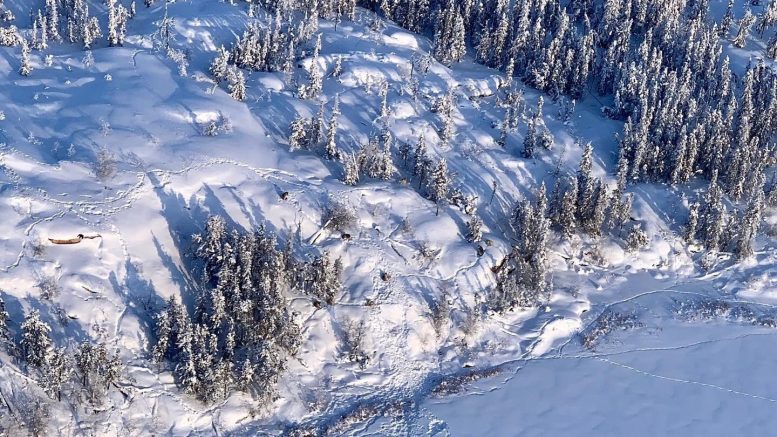The GNWT and Tłı̨chǫ Government will help support the barren-ground caribou recovery in the NWT by culling wolves.
George Mackenzie is the Grand Chief of the Tłı̨chǫ Government.
“The caribou are in danger and we all need to want to do more to assist in their recovery,” Grand Chief Mackenzie said in a news release. “We have had meetings with our Elders and our traditional knowledge affirms that wolves are an important animal and must be treated with great respect even when harvesting them.”

The GNWT along with the Tłı̨chǫ Government announced their plan on Friday to kill 300 wolves. (L-R) Bruno Croft, Superintendent for the North Slave Region – Department of Environment and Natural Resources, GNWT: Michael Birlea, Manager, Lands Protection and Renewable Resources – Tłı̨chǫ Government, Tammy Steinwand-Deschambeault, Director, Culture and Lands Protection – Tłı̨chǫ Government, and Brett Elkin, A/ADM, Operations – Department of Environment and Natural Resources, GNWT. (Photo courtesy of the GNWT)
Both the proposal and the Range Plan are part of a wide range of management actions the GNWT and Tłı̨chǫ Government and their co-management partners are taking to support the recovery of the Bathurst and Bluenose-East caribou herds. The total population of Bathurst caribou in the territory is roughly 8,200 and the Sahtì ekwǫ̀ (Bluenose-East) caribou population is around 19,000 animals.
According to the release, on average, a single wolf can eat 23-29 caribou per year as the wolves can prey on male and female caribou, both adults and calves. However, cow and calf mortality has a greater impact on the overall health of a herd.
The GNWT states that given the current low numbers of Bathurst and Bluenose-East caribou, this level of predation is a significant contributor to caribou mortality.
Grand Chief Mackenzie says the “Tłı̨chǫ Government is committed to the training of harvesters for the purpose of a controlled wolf harvest using Tłı̨chǫ traditional knowledge and practices in the wintering ranges of the Bluenose East and Bathurst Caribou.”
Wolves are the primary predator of barren-ground caribou in the NWT according to the GNWT. Both the Bathurst and Bluenose-East caribou herds have experienced rapid declines in recent years and the GNWT has heard clearly that more needs to be done to manage predators to support caribou during this period of decline.
The plan is to kill 200 wolves in the Bluenose-East range and another 100 in the Bathurst herd region. The proposal is part of a wide range of management actions by the two governments to support the recovery of these herds. Aerial removal of wolves will only be considered if removal targets cannot be met and they also plan to monitor wolves with tracking collars to learn more about the pack’s movements.
The GNWT has also invited Nunavut wolf harvesters to join the hunt. Inuit hunters who kill wolves in the North Slave wolf harvest incentive area will be paid $1,200 for each wolf-$900 from the GNWT and $300 from the Government of Nunavut. The goal is to reduce 60 to 80 per cent of wolves from the winter ranges.
“It is time to put stronger actions in place before it is too late for the caribou,” Grand Chief Mackenzie said.
The joint proposal is now before the Wek’èezhìı Renewable Resources Board (WRRB) for review.
arthur.green@cklbradio.com
Twitter.com/artcgreen
Arthur C. Green is from Whitbourne Newfoundland and graduated from the CNA Journalism Program. Arthur also studied Business Marketing and Political Science at Memorial University in Essex England and St. John's Newfoundland. Green has worked as a spot news photographer/journalist with such news organizations as Vista-radio, CBC, CBC Radio, NTV, Saltwire and Postmedia in Alberta.





